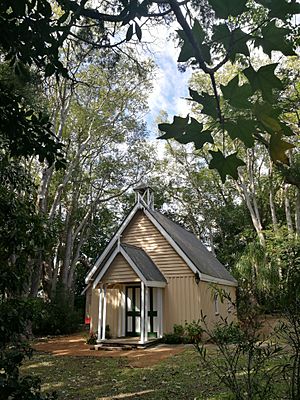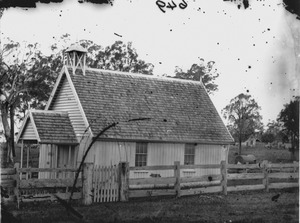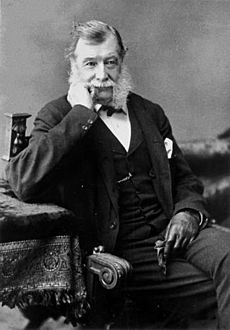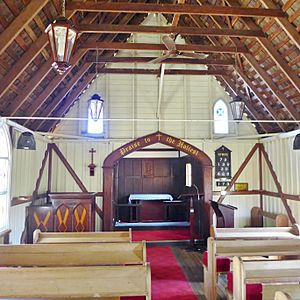St Andrew's Church, Ormiston facts for kids
Quick facts for kids St Andrews Church, Ormiston |
|
|---|---|

The Historic Anglican Church of St Andrew, August 2017
|
|
| Location | Wellington Street, Ormiston, City of Redland, Queensland, Australia |
| Design period | 1840s–1860s (mid-19th century) |
| Built | c. 1868 |
| Official name: St Andrews Church | |
| Type | state heritage (built, landscape) |
| Designated | 21 October 1992 |
| Reference no. | 600774 |
| Significant period | 1860s (historical) 1860s (fabric) ongoing (social) |
| Significant components | trees/plantings, tower – bell / belfry, furniture/fittings, church |
| Lua error in Module:Location_map at line 420: attempt to index field 'wikibase' (a nil value). | |
St Andrews Church is a very old and special Anglican church. It is located on Wellington Street in Ormiston, Queensland, Australia. The church was built around 1868. It is so important that it is listed on the Queensland Heritage Register. This means it is protected because of its history and unique features.
Contents
History of St Andrews Church
This church, made of timber boards and battens, was built around 1868. It was part of the large Ormiston estate owned by a person named the Honourable Louis Hope. At first, it was a private chapel for the Hope family. It also served as a Sunday school and a regular school for children.
Louis Hope and the Ormiston Estate
Louis Hope bought land in the Raby Bay area between 1853 and 1855. He then created the Ormiston estate and a sugar plantation there. The Hope family lived at Ormiston House from about 1864 or 1865 until they moved back to England in 1882. The land right around Ormiston House was over 200 acres. It was bordered by Raby Bay, Hilliards Creek, and Eckersley Street. Hope also owned many other large areas of land nearby.
Louis Hope was very important in starting the sugar industry in Queensland. In 1864, he produced the colony's first sugar that was processed in a factory at Ormiston. The land where St Andrews Church stands was bought by Hope in mid-1863. It is believed that James Yorston, a Scottish worker on Hope's estate, built the chapel. The timber for the church was cut right there at Ormiston. It was then cut into size and shaped using a special tool called an adze.
Early Features and Use
When it was first built, the chapel was surrounded by bunya pines and many flowering trees. A simple fence with a picket gate separated it from the road. The early church had a roof made of wooden shingles. Its windows were double-hung with six small glass panes. The building sat directly on the ground and had a cement floor. The chancel (the area around the altar) and the vestry (a room for clergy) were added later.
This chapel was built at least six years before the first Anglican church in Cleveland. At first, church services were led by regular people or by priests from the St Marys Church of England parish. The building also worked as a school for the children of people who worked on Hope's estate. This continued until the Ormiston State School opened in 1872.
Becoming a Community Church
In 1882, the Hope family gave the chapel and a small piece of land (0.2 hectares) to the Anglican Church as a gift. Along with St Pauls Church in Cleveland (built in 1874), St Andrews became part of the new Cleveland parish, which was created in 1881. The church was never officially "dedicated" in a special ceremony.
The church had big repairs in 1905 and 1920. By 1924, there was a lot of damage from termites, so more repairs were needed. In the 1930s, the building was placed on a brick base. In the 1960s, the inside walls were covered, and a special writing on the chancel arch was removed. Since the late 1950s, a group called the "Friends of St Andrews" has helped take care of the church. This group welcomes everyone, no matter their religion. Church services are still held there today.
What the Church Looks Like
St Andrews Church is a small building made with an old style of timber construction. You can see it clearly from the road, surrounded by tall, old trees. Its roof is made of corrugated iron and has a pointed shape, called a gable roof. This roof runs from north to south.
There is a small bell tower, called a belfry, over the entrance on the north side. A small porch with its own gable roof is attached to the entrance. The main entrance doors have four panels and old metal fittings. On the south side, the chancel (the part of the church where the altar is) extends out. A vestry (a room for the priest) is also attached there.
Decorative points, called finials, are on the belfry and the northern end of the roof. The finial on the southern end has been removed. The gutters on the church were taken off recently. The windows in the main part of the church are tall and narrow with pointed tops, called lancet windows. They have two rectangular sections and a pointed section above, each with a central bar. There are also windows that open outwards, called casement windows, in the chancel and vestry.
Inside, the floor of the main part of the church is made of hardwood timber boards. The floorboards in the porch and vestry have different edge styles. The hardboard covering the nave walls was removed after 1987. This shows the original timber boards and battens, which have been painted recently. You can clearly see the original wooden shingles under the iron roof in the main part of the church. These shingles are still unpainted. The church pews (benches) are made of scrubbed beech wood. The original structure of the church is very clear and interesting, and it sits in a beautiful, scenic spot.
Why St Andrews Church is Special
St Andrews Church was added to the Queensland Heritage Register on 21 October 1992. It met several important rules to be listed.
Demonstrating Queensland's History
St Andrews Church in Ormiston, built around 1868, is important for showing how European settlement first grew in Cleveland. It also shows the connection to Louis Hope and how the sugar industry started in Queensland.
Rare and Unique Features
The church is special because it is a rare example of "board and batten" construction that still exists in southeast Queensland. It is also important because the building and its original fittings are still very much intact.
Beautiful Design
The church is important because of its graceful and complete architectural design. It looks very nice and has kept its original style.
Community Connection
The church has a strong connection with the community and is important for spiritual reasons. It is the oldest Anglican church in the Cleveland parish.




